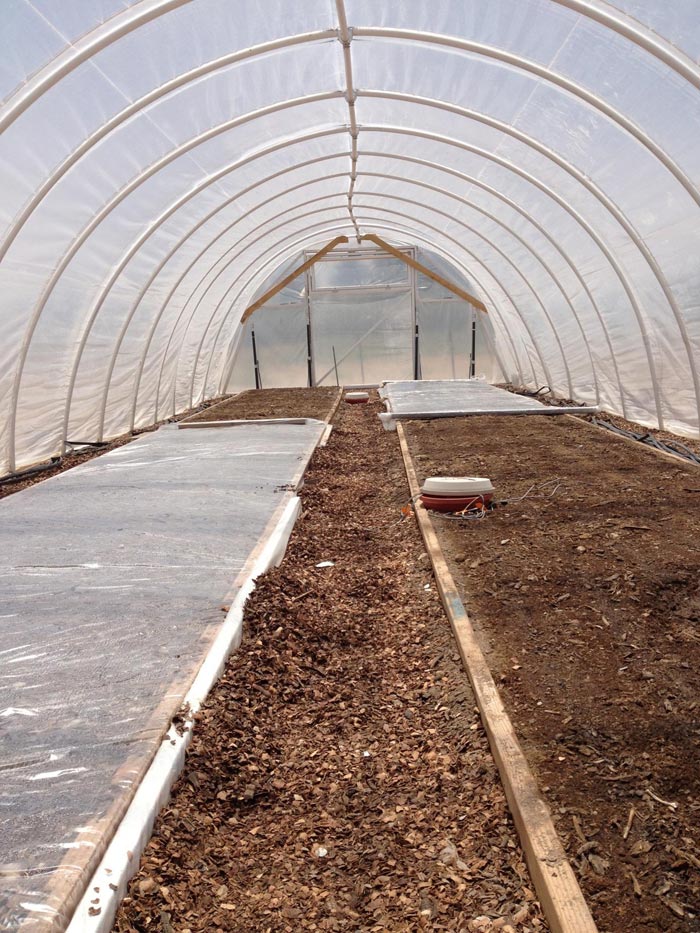Polyethylene mulch, glazing create optimal conditions for soil solarization

Researchers found that soil solarization was most effective when moist soil was covered tightly with polyethylene inside a high tunnel covered with glazing. Credit: Photo by U.K. Schuch
Soil solarization, a process that uses solar radiation to rid the soil of pests, is most common in regions with high solar radiation and high temperatures during the summer season. An alternative to soil fumigation, the process is used either alone or in combination with fumigants.
To accomplish solarization, solar radiation is used to passively heat moist soil covered with clear plastic sheeting, with the goal of increasing soil temperatures to the point where they are lethal to soilborne organisms. The effectiveness of solarization is based on the actual maximum soil temperature reached and the amount of time the high temperatures can be sustained.
According to the authors of a study published in HortScience, the semiarid climate in southern Arizona is ideal for employing soil solarization. Ursula Schuch, advisor to former graduate student Kristen Hanson, said that June is the optimal time for solarization in the region because daily solar radiation and temperatures are higher in June than in any other month.
Low relative humidity during early summer months, combined with high temperatures and high solar radiation, provides growers with opportunities to use solarization in high tunnels while their production beds are fallow.
Schuch, Hanson, and research specialist Tilak Mahato designed experiments to determine the efficacy of using clear polyethylene mulch on the soil surface inside high tunnels covered with clear polyethylene glazing to solarize the soil during the hottest time of the year. “One goal of the study was to provide growers using high tunnels in the semiarid Southwest with information that may be beneficial to protecting their crops from weed and other pest populations,” Schuch said.
The experiments took place in two high tunnels in Tuscon. Polyethylene (PE) glazing was kept on each of the two high tunnels from late May through early June. Half of each of the growing beds was covered with solid, clear polyethylene mulch that contained an ultraviolet stabilizer that prevented degradation from solar radiation.
“We found that the most effective solarization strategy was to keep the glazing on the high tunnels in conjunction with a 25.4-mm PE cover on the well-irrigated beds,” the authors wrote. “When daily solar radiation averaged 29.8 MJ•m-2 and outside temperatures reached 38 °C, the soil at 5-cm depth exceeded 45 and 55 °C for almost 15 hours and 8 hours, respectively, each day.
This treatment resulted in a significant period each day when temperatures exceeded the thresholds to effectively kill many soil pathogens, pests, and weeds in a relatively short time.” In the experiments, soil temperatures to 15-cm depth increased such that disinfestation for many undesirable organisms would be completed in less than 1 week.
The authors added that achieving soil solarization with PE mulch covering the soil without glazing on the high tunnels required a longer duration. The results also determined that solarization with glazing only on the high tunnel was least effective in raising soil temperatures.
The complete study and abstract are available on the ASHS HortScience electronic journal web site: http://hortsci.ashspublications.org/content/49/9/1165.abstract
Founded in 1903, the American Society for Horticultural Science (ASHS) is the largest organization dedicated to advancing all facets of horticultural research, education, and application.
More information at http://ashs.org
Media Contact
All latest news from the category: Agricultural and Forestry Science
Newest articles

Machine learning algorithm reveals long-theorized glass phase in crystal
Scientists have found evidence of an elusive, glassy phase of matter that emerges when a crystal’s perfect internal pattern is disrupted. X-ray technology and machine learning converge to shed light…

Mapping plant functional diversity from space
HKU ecologists revolutionize ecosystem monitoring with novel field-satellite integration. An international team of researchers, led by Professor Jin WU from the School of Biological Sciences at The University of Hong…

Inverters with constant full load capability
…enable an increase in the performance of electric drives. Overheating components significantly limit the performance of drivetrains in electric vehicles. Inverters in particular are subject to a high thermal load,…





















